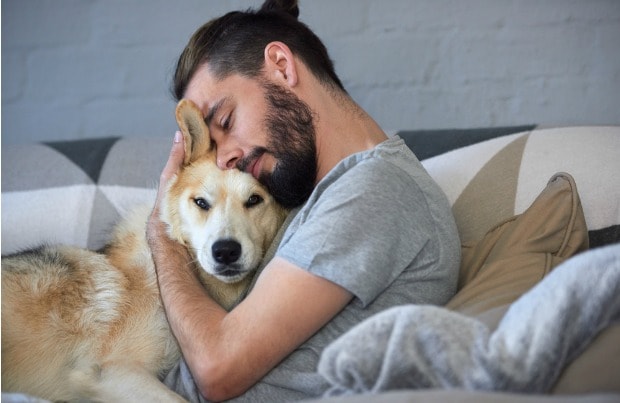Running away in adult dogs is, in most cases, a learned and reinforced response. How does a dog learn to run away? Several scenarios or situations play out on a regular basis among my clients with adult dogs.
- Boredom: A dog left unattended in a yard can quickly learn that the grass might be greener on the other side. All it takes to reward your dog for taking a stroll out of his yard is an encounter with a friendly neighbor, dog or chasing a squirrel. Once he has been rewarded, he will only want to do it again. This also holds true for dogs in a fenced yard. It only takes one time for a gate to be left open or for a dog to dig under or jump over the fence to find something to do.
- Being chased: Your dog gets away for the first time and you panic and take off after him. Chasing and being chased for a dog is great fun. Watch dogs that are playing together. At one point or another they will chase each other. When you chase your dog, he thinks you are playing and will continue to run away from you.
- Lack of yraining: Many owners, especially those with the luxury of a fenced-in yard, have simply not trained their dog. Instead, they depend on management. When that fails, the dog is off and running, overwhelmed by the new world around him.
Improper or incomplete training can also be a contributing factor. Lena Skov, owner of Understanding Our Dogs LLC, in Stanley, North Carolina, believes this is a huge factor.
“First of all, because the dog has never been fully taught the beauty of freedom, trust and responsibly,” Skov says. “Secondly, owners send our mixed signals when trying to get their dog to come back.”
All of this comes into play with my friend Cici, who lives out of town. She has a very athletic Dogue de Bordeaux named Frank. He runs away every chance he gets. After a bad training experience, Cici decided that life would be just fine if Frank spent his days in the safety of the fenced-in backyard. Instead, Frank found the kids down the street much more entertaining on boring afternoons. Before long, Frank managed to find a way to escape to join the kids. My friend, in a panic, would then chase Frank around the neighborhood, much to his pleasure.
Once she would finally get Frank back, she would tell him he was a bad dog. All of this has created a vicious cycle of Frank planning his escapes, playing with the kids, getting chased by his owner and ending with a scolding; this has been going on for about four years. Luckily for her, Frank never goes too far from home.
There is also a common misconception that hunting breeds can’t be trained to stay home. This is simply not true. The above holds true for them, too. Sometimes you need to be more creative in what you use to reinforce a Beagle, but it can be done.
The Training Fix
It is never too late to start training your adult dog, or to fix incomplete or improper training. Expect that in the beginning it will take longer than if you started with a puppy, because you have to undo all the previously learned, unwanted behavior.
Teach Your Dog To Stay
For door-dashers, start with teaching the “stay” command at the door. This can be one of the most useful behaviors to teach a dog. If you have never taught a “stay” before, know that it is not very difficult. If you are worried about your dog getting loose, put him on a long line and have a family member hold it or anchor it to a heavy piece of furniture. Here are the steps for teach your dog to stay:
- Ask your dog to sit in a location about 5 feet from the door. If you have a carpeted area or throw rug, use that as your dog’s place to stay.
- Hold your hand up like a stop sign and tell your dog to stay. Take a step back. If your dog stays, say “good” and step in and give your dog a treat.
- Slowly work your way to the door, adding a step at a time.
- If your dog gets up, just return him to the original spot and start over.
- Once you can put your dog on a stay and walk to the door without him getting up, try turning the doorknob. If your dog stays, say “good” and offer a dog treat. Work each part of opening the door while your dog stays. If at any time he gets up, close the door and start over.
- Work on this until you can stand with the door wide open and your dog remains seated. Make sure before you reach this point that you use a long line. You do not want to undo your hard work with your dog running out the door.
Teach A Reliable Recall
In addition to teaching to your dog to stay, you can teach him to come when called. Here’s how to do that:
- Teach your dog that good things happen when he hears the word “come” or “here.” Do this by simply saying the word and offering a treat.
- When your dog starts getting excited when you say the word, take a couple of steps away.
- Call your dog.
- When he starts moving, say “good” and treat him when he gets to you.
- Slowly build up your distance.
- Repeat this outside with your dog on a long line.
Teach An Emergency Recall
There might come a time when the usual come command falls short. Enter the emergency recall, which involves a whistle. A whistle can carry farther than your voice and get your dog’s attention under heavy distraction.
Using a referee whistle or a regular dog whistle that you can hear, blow a couple of times on the whistle and offer a very high-value treat, such as roasted chicken. You want it to be a treat your dog really gets excited about and a treat you will only pair with the whistle. Follow the same steps as above.
The whistle blow becomes your cue word in place of “come” or “here.” When your dog starts moving toward you, say “good” and give him the treat when he reaches you. The whistle should always be paired with this high-value treat.
By: Jennifer Mauger
Featured Image: PhilStev/iStock/Thinkstock
Share:









